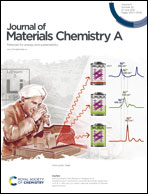Colocalization of light harvesting and catalytic units in a ‘soft’ coordination polymer hydrogel toward visible-light driven photocatalytic hydrogen production†
Abstract
Colocalization of essential molecular components in a solvated soft supramolecular assembly towards realizing visible-light-driven hydrogen evolution would be an exciting approach for sustainable energy by generating clean solar fuel. In this study, we report the preparation and characterization of a coordination polymer gel (Zn-TPY-ANT CPG) formed by the self-assembly of Zn2+ and an anthracene–terpyridine based low molecular weight gelator (TPY-ANT LMWG). The 1D nanofibrous CPG in the hydrogel state shows the potential to perform visible-light-driven (400–750 nm) photocatalytic water reduction and produce a considerable amount of hydrogen (12.02 mmol g−1 in 22 h). Furthermore, H2 evolution can be enhanced significantly (18.03 mmol g−1 in 22 h) upon illumination with the full-range of light (290–750 nm). In this supramolecular assembly, the ANT unit acts as a light-harvesting moiety whereas the [Zn(TPY)2]2+ center acts as a catalytic site. We believe that such a design of soft hybrid materials would have a positive impact on developing a non-precious, stable, and recyclable photocatalyst material for H2 production.



 Please wait while we load your content...
Please wait while we load your content...